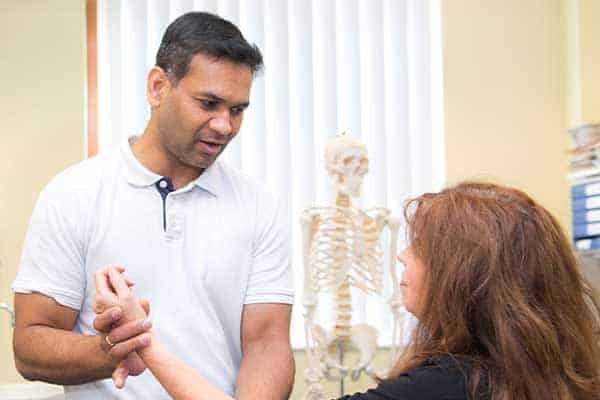Tennis elbow is pain on the outer side of your elbow.
What causes tennis elbow?
The site of the pain in tennis elbow is where some tendons from your forearm muscles attach to the bone around your elbow. The condition is usually caused by overuse of your forearm muscles in repeated actions such as wringing clothes or manual work (particularly with twisting movements such as using a screwdriver). Playing tennis or other racquet sports can also cause tennis elbow.
What are the symptoms?
For most people with tennis elbow, the pain only occurs when they use their forearm and wrist, particularly for twisting movements such as turning a door handle or opening a jar.
For some people:
- The pain is constant – occurring at rest and affecting sleep.
- The pain travels from the elbow towards the wrist.
- It is difficult to hold items such as a knife/fork, a cup or a pen.
- It is difficult to straighten the arm fully.
- There is stiffness in the affected arm.
How is tennis elbow diagnosed?
Your doctor can usually diagnose tennis elbow by talking to you about your symptoms and by examining your arms. Investigations are not usually needed to diagnose tennis elbow.
What are the treatment options for tennis elbow?
Self-management is often all that is needed and often the best long term solution in treating tennis elbow.
Treatment includes the following:
Put an ice pack on your elbow for 10 minutes every 3 to 4 hours for 2 to 3 days or until the pain goes away. (Do not put ice directly next to skin as it may cause ice burn. Wrap it in a damp tea towel.)
You may try a tennis elbow strap. This strap wraps around the forearm below the elbow, acting as a new attachment site for the forearm muscles and keeping them from pulling on the painful epicondyle. Some people find this helpful, especially with a repetitive job.
You could try anti-inflammatory painkillers such as ibuprofen. Some anti-inflammatory painkillers also come as creams or gels, which you can rub over your painful elbow. These tend to produce fewer side-effects than those taken by mouth. If you cannot take anti-inflammatory painkillers, other painkillers such as paracetamol, with or without codeine added, may be helpful. Ask your doctor or pharmacist for advice.
Some people find natural anti-inflammatory remedies useful.
What is the prognosis (outlook) for tennis elbow?
Pain from tennis elbow usually lasts for six to twelve weeks. In some people it can go after as little as three weeks. It tends to be a self-limiting condition, meaning that without treatment it will resolve in 80-90% patient in 1-2 years.
If your symptoms persist your doctor may recommend:
Physiotherapy for progression and modification of exercises as well as clarification of the diagnosis.
Other treatments eg, ultrasound, acupuncture and massage have minimal evidence of long term benefit as they do not improve the strength of the tendon.
NICE found limited evidence in the literature to support the use of corticosteroid injections for tennis elbow.
If the symptoms have been present for 18 months surgery may need to be considered, but most people will improve before this is necessary.
How can I prevent recurrence of tennis elbow?
Ice your elbow after exercise or work.
In job-related activities, be sure your posture is correct and that the position of your arms during your work doesn’t cause overuse of your elbow or arm muscles.
Try work related modification if possible and pace your activities when you can.

How to get referred
Find out how to get referred to Practice Plus Group MSK & Diagnostics for NHS treatment.




